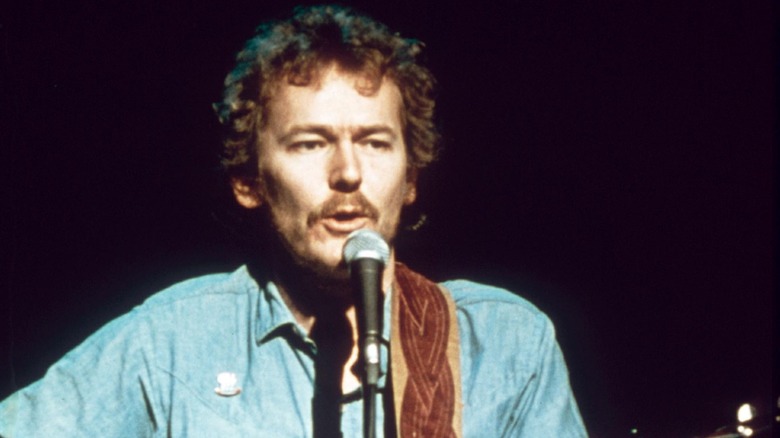The Heartbreaking Death Of Gordon Lightfoot
Gordon Lightfoot died on May 1, the New York Times reported. According to the outlet, the 84-year-old singer died at a Toronto hospital.
Often regarded as "Canada's greatest songwriter," as noted by Vanity Fair, Gordon Lightfoot had a tremendous amount of influence over the world of folk-pop music. He was one of the best-selling artists in his genre of all time, with over 10 million albums sold and more than 18 songs charting in the Top 40 in Canada and the U.S. Bob Dylan, who referred to Lightfoot as his mentor, once said, "Every time I hear a song of his, it's like I wish it would last forever."
Lightfoot was also an incredibly busy artist. Over the course of a career spanning several decades, he cut back on his touring commitments only when he was diagnosed with Bell's Palsy in the early 1970s. He was lauded as legendary for recording another studio album at 80 years old, which featured only his voice and a guitar, via All Music. For Lightfoot, the only real problem he struggled with in terms of his music was deciding which songs — he had over 200 — to play at his concerts, per the Lubbock Avalanche-Journal.
Gordon Lightfoot's early love of music
For Gordon Lightfoot, music was a way of being. He grew up in a musical household where his mother nurtured his natural talent for singing, according to All Music. At just 5 years old, Lightfoot began singing in church. At 10 years old, he won second place in a local talent competition, and at 12, he started taking piano and voice lessons. He won the Kiwanis Festival competition at 13 years old, per The Montrealer, and also had the opportunity to perform at Massey Hall in Toronto, considered to be Canada's equivalent to Carnegie Hall (via The Canadian Encyclopedia).
In his teenage years, Lightfoot expanded his musical horizons by teaching himself how to play guitar, via All Music. He also learned drumming, played folk music with a group called the Teen Timers, and performed with a barbershop quartet. It wasn't long before Lightfoot decided to move to California to pursue orchestration and jazz composition in college, where he started landing gigs on demo recordings and commercial jingles. However, California wasn't quite his scene. He decided to move back home instead, where he was drawn once again to folk and country music.
Gordon Lightfoot's path to stardom
Gordon Lightfoot performed in various singing groups in the 1960s, including a vocal group called The Swinging Eight and the duo Two Tones, as noted by All Music. By the time 1963 came around, however, Lightfoot decided to trek out on his own. That's when he caught the attention of Canadian folk duo Ian and Sylvia Tyson, who happened to hear him perform at a club in Toronto. They told their manager, Albert Grossman, about the talented young artist, which prompted Grossman to offer Lightfoot a management contract.
Major artists such as Peter, Paul and Mary began recording Lightfoot's songs, many of which became hits. By 1966, Lightfoot accepted another contract offer. This time, it was a recording contract with United Artists Records. His first solo album was modestly successful and included three songs written by him that had already been recorded by other artists (via Discogs). Per Second Hand Songs, one of the tracks, "Ribbon of Darkness," became one of Lightfoot's first songs to chart in the U.S.
Lightfoot then released three more studio albums, all of which helped him grow from a budding artist into a major Canadian star. While he was still known only as a songwriter in the U.S., the stardom in Canada helped shape Lightfoot's career for the better. In 1970, he left his recording contract for a new one with Reprise label.
Gordon Lightfoot's later career
The 1970s were a busy decade for Gordon Lightfoot, who released nine albums in that time span, per Discogs. As All Music explained, his first album of the decade was "Sit Down Young Stranger," which included "If You Could Read My Mind." The song worked its way up to the top five on the Billboard Hot 100 Chart in 1971 and was Billboard's No. 1 Adult Contemporary song for 13 weeks. As a result, the album was later renamed after the hit single.
Lightfoot finally found himself as an international success story. His other top hits from the decade included "Sundown" in 1974, "Rainy Day People" in 1975, and "The Wreck of Edmund Fitzgerald" in 1976. But by the 1980s, Lightfoot seemed to be slipping out of the spotlight. A huge throng of loyal fans would still come for his annual Massey Hall shows, according to All Music. However, his popularity in the U.S. was on the decline.
Still, Lightfoot's mark on music was unwavering. In the late 1980s, he was inducted into the Canadian Music Hall of Fame. In the 1990s, he embarked on a revival and recorded two hit albums: "Waiting for You" and "A Painter Passing Through." His 2004 album "Harmony" was also met with praise, especially because he had worked on it while battling serious health issues. Then in 2020, Lightfoot released his first studio album in 16 years at 80 years old, titled "Solo."
Gordon Lightfoot's health and personal life
Gordon Lightfoot suffered from his fair share of health scares. Per All Music, he was diagnosed with Bell's Palsy in 1972. The illness left half of his face paralyzed for some time and caused him to scale down on the number of tours in his show at the time. Lightfoot avoided other major health issues until 30 years later in 2002, when he was rushed to the hospital for a ruptured abdominal aortic aneurysm. He had not only a tracheotomy but four surgical operations. By the end of it all, he was in a coma for six weeks. Yet another serious health scare arose in 2006 when a stroke left him unable to play the guitar for months. Still, Lightfoot plowed on. He used a guest guitarist on occasion and was back to playing on his own in 2007.
Through it all, Lightfoot had several romantic relationships and fathered six children, according to the Orangeville Citizen. He married his first wife, Brita, in 1963, per Alchetron. The pair had two children together, Fred and Ingrid, before divorcing in 1973. In 1989, Lightfoot married Elizabeth Moon who gave birth to Miles and Meredith. The couple divorced in 2011, though Lightfoot said they had been separated for nine years. In 2008, Lightfoot met actor Kim Hasse at a concert in Florida (via Zoomer). The two got married in 2014.




